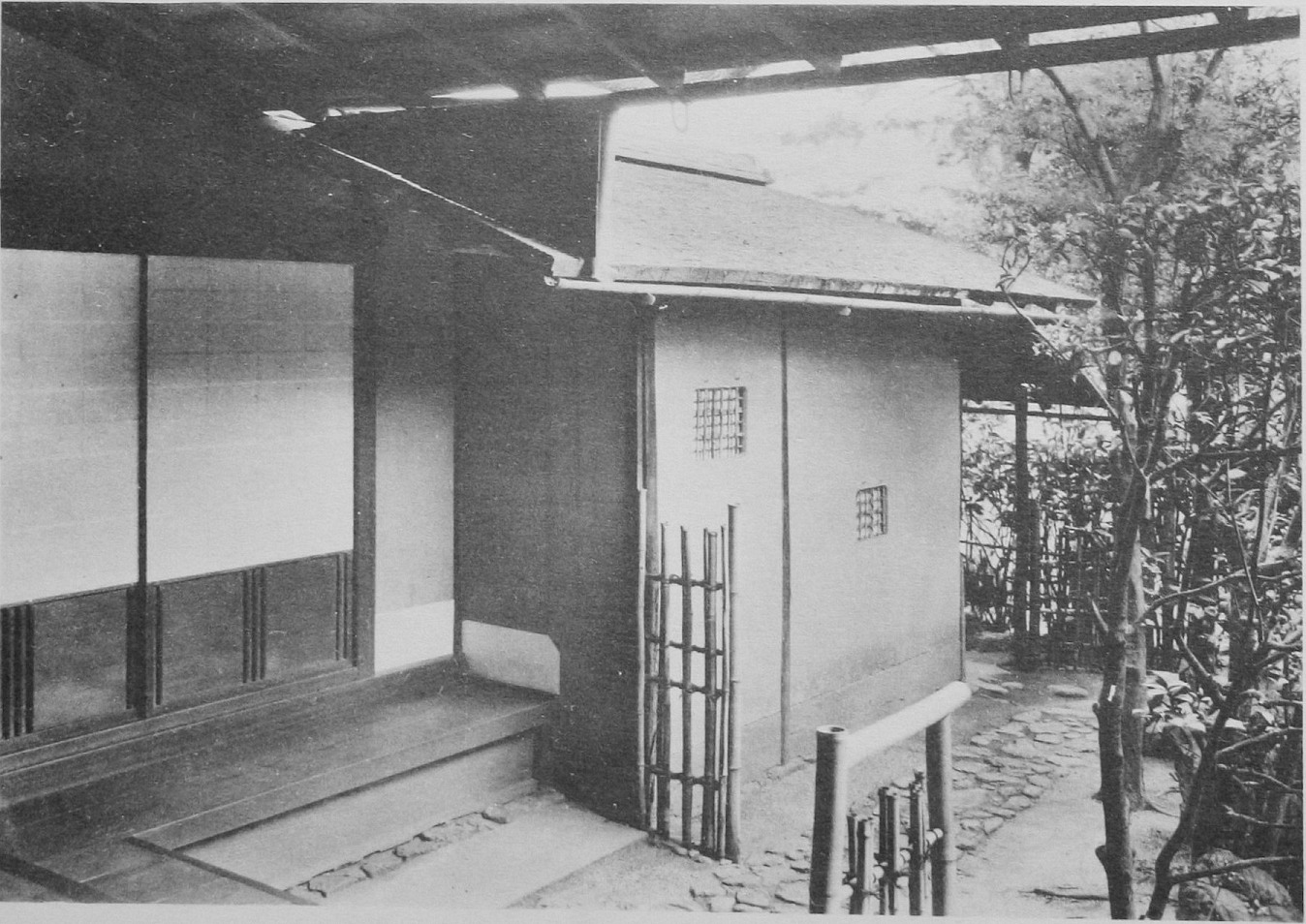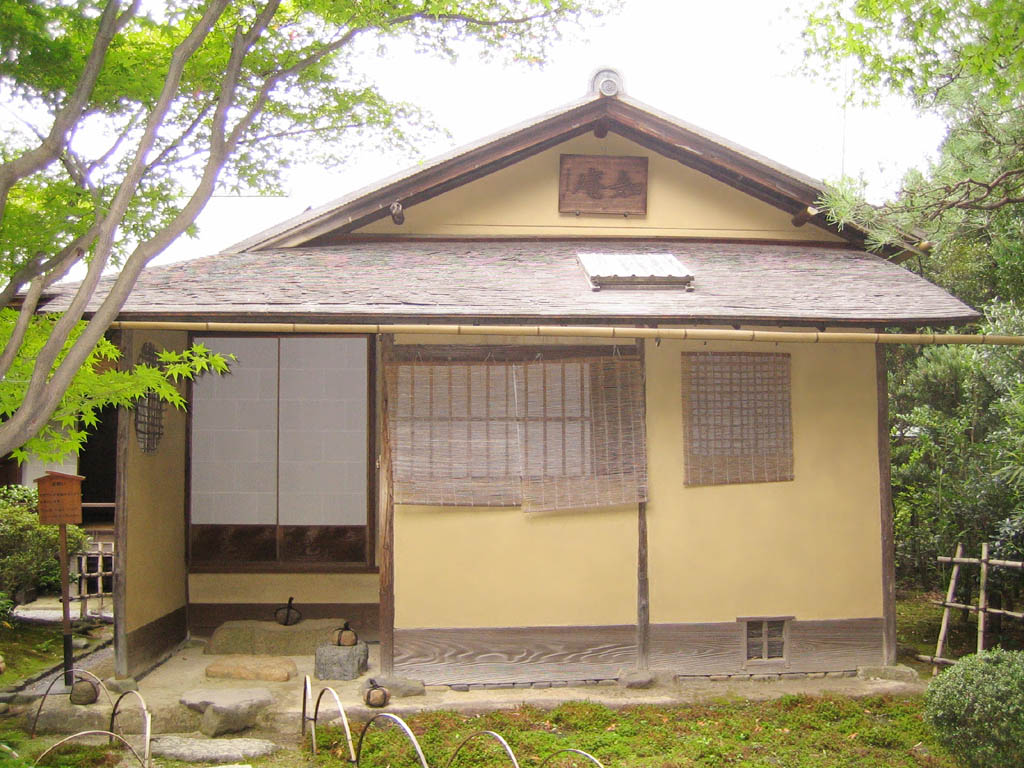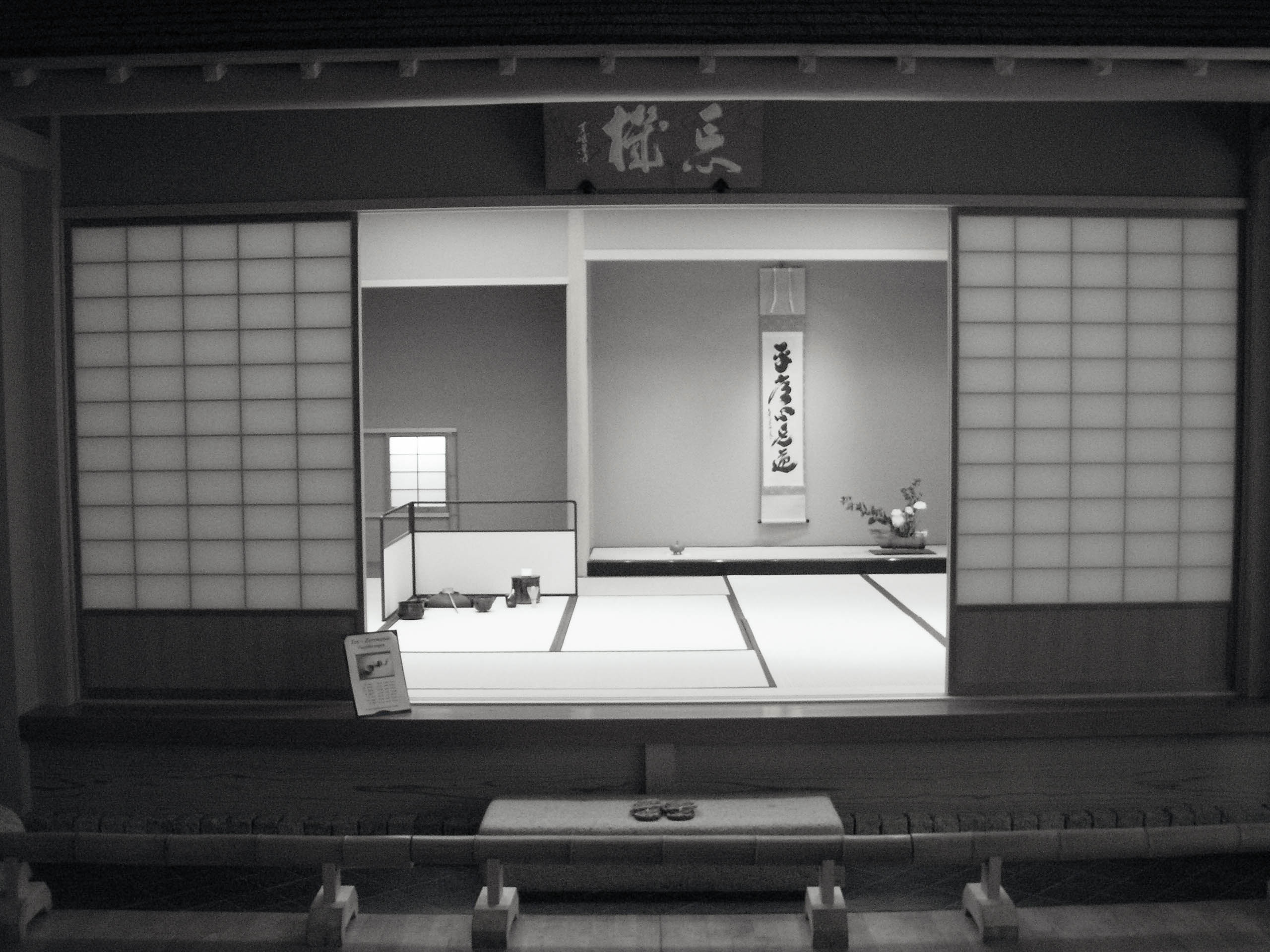|
Tai-an
is a Momoyama period '' chashitsu'' (Japanese tea house) located at Myōki-an temple in Yamazaki, Kyoto. Tai-an was designed by the great tea master Sen no Rikyū in 1582. Sen no Rikyū was named the tea master of Toyotomi Hideyoshi that same year, following Oda Nobunaga's death, and as Hideyoshi was battling around the area at the time, they often held tea ceremonies there. In fact it is often said that it was built for exactly this purpose. An example of the smallest type of ''chashitsu'', its main layout consists of one ''tatami'' mat for the host and another one for the guest. On the north side, where the tea house connects with another building, there is a ''tokonoma''. The entrance, on the south side, is said to have been designed larger than usual in order to allow Hideyoshi to enter with his armor on. On the west side there is another one mat area with a shelf for tea utensils, and a tablet with the name of the teahouse hanging near the ceiling.Kirby, John B. (1962). '' ... [...More Info...] [...Related Items...] OR: [Wikipedia] [Google] [Baidu] |
List Of National Treasures Of Japan (residences)
The term " National Treasure" has been used in Japan to denote cultural properties since 1897. The items are selected by the Ministry of Education, Culture, Sports, Science and Technology based on their "especially high historical or artistic value". This list presents 14 entries of residential structures from 15th-century feudal Muromachi period to the early modern 17th-century Edo period. The structures listed include teahouses, '' shoin'', guest or reception halls and other rooms which are part of Japanese domestic architecture, while most of the structures are located in temples, one is a castle. In 2009, the early 20th century Akasaka Palace was designated as National Treasure in the category of "modern residences" (Meiji period and later). Because it is the only National Treasure in this category, it is listed together with the 14 pre-Meiji period structures. The foundations for the design of today's traditional Japanese residential houses with tatami floors were establish ... [...More Info...] [...Related Items...] OR: [Wikipedia] [Google] [Baidu] |
TAIAN In MyokiAN Kyoto
__NOTOC__ Taian, Tai-an, or Tai'an may refer to: Japan *Tai-an (待庵), a '' chashitsu'' tea room at Myōki-an temple, Japan, famous for its connection with Sen no Rikyū, designated a National Treasure *Taian, a day of Rokuyō in the Japanese calendar Places *Tai'an, a prefecture-level city in Shandong, China * Tai'an County, a county in Liaoning, China * Tai'an Subdistrict (太安街道), a subdistrict in Xi'an District, Liaoyuan, Jilin, China * Tai'an Village, in Beiwan, Jingyuan, Baiyin, Gansu, China Places in Taiwan * Tai-an, Miaoli, a township in eastern Miaoli County, Taiwan * Tai'an Station (Taichung), a railway station in Taichung, Taiwan Towns in People's Republic of China * Tai'an, Wanzhou District, Chongqing (太安), in Wanzhou District, Chongqing * Tai'an, Tongnan District, Chongqing (太安), in Tongnan District, Chongqing *Tai'an, Jiangsu (泰安), in Yangzhou, Jiangsu * Tai'an, Shaanxi (太安), in Yijun County, Shaanxi * Tai'an, Luzhou (泰安), in Luzhou, Si ... [...More Info...] [...Related Items...] OR: [Wikipedia] [Google] [Baidu] |
Chashitsu
''Chashitsu'' (, "tea room") in Japanese tradition is an architectural space designed to be used for tea ceremony (''chanoyu'') gatherings. The architectural style that developed for ''chashitsu'' is referred to as the ''sukiya'' style (''sukiya-zukuri''), and the term '' sukiya'' () may be used as a synonym for ''chashitsu''. Related Japanese terms are ''chaseki'' (), broadly meaning "place for tea", and implying any sort of space where people are seated to participate in tea ceremony, and ''chabana'', "tea flowers", the style of flower arrangement associated with the tea ceremony. Typical features of ''chashitsu'' are ''shōji'' windows and sliding doors made of wooden lattice covered in a translucent Japanese paper; ''tatami'' mat floors; a ''tokonoma'' alcove; and simple, subdued colours and style. The most typical floor size of a ''chashitsu'' is 4.5 tatami mats.''Kōjien'' Japanese dictionary, entry for 'chashitsu'. Definition In Japanese, free-standing structures ... [...More Info...] [...Related Items...] OR: [Wikipedia] [Google] [Baidu] |
Chashitsu
''Chashitsu'' (, "tea room") in Japanese tradition is an architectural space designed to be used for tea ceremony (''chanoyu'') gatherings. The architectural style that developed for ''chashitsu'' is referred to as the ''sukiya'' style (''sukiya-zukuri''), and the term '' sukiya'' () may be used as a synonym for ''chashitsu''. Related Japanese terms are ''chaseki'' (), broadly meaning "place for tea", and implying any sort of space where people are seated to participate in tea ceremony, and ''chabana'', "tea flowers", the style of flower arrangement associated with the tea ceremony. Typical features of ''chashitsu'' are ''shōji'' windows and sliding doors made of wooden lattice covered in a translucent Japanese paper; ''tatami'' mat floors; a ''tokonoma'' alcove; and simple, subdued colours and style. The most typical floor size of a ''chashitsu'' is 4.5 tatami mats.''Kōjien'' Japanese dictionary, entry for 'chashitsu'. Definition In Japanese, free-standing structures ... [...More Info...] [...Related Items...] OR: [Wikipedia] [Google] [Baidu] |
Sen No Rikyū
, also known simply as Rikyū, is considered the historical figure with the most profound influence on ''chanoyu,'' the Japanese "Way of Tea", particularly the tradition of '' wabi-cha''. He was also the first to emphasize several key aspects of the ceremony, including rustic simplicity, directness of approach and honesty of self. Originating from the Sengoku period and the Azuchi–Momoyama period, these aspects of the tea ceremony persist. Rikyū is known by many names; for consistency, he will be referred to as Rikyū in this article. There are three '' iemoto'' ('' sōke''), or 'head houses' of the Japanese Way of Tea, that are directly descended from Rikyū: the Omotesenke, Urasenke, and Mushakōjisenke, all three of which are dedicated to passing forward the teachings of their mutual family founder, Rikyū. Early life Rikyū was born in Sakai in present-day Osaka Prefecture. His father was a warehouse owner named , who later in life also used the family name Sen, a ... [...More Info...] [...Related Items...] OR: [Wikipedia] [Google] [Baidu] |
Tokonoma
A , or simply , is a recessed space in a Japanese-style reception room, in which items for artistic appreciation are displayed. In English, a could be called an alcove. History There are two theories about the predecessor of : the first is that it derives from the room structure of the , which flourished in the Heian period (794–1185) and declined in the Muromachi period (1336–1573); the second is that it derives from the room structure of Zen monasteries in the Kamakura period (1185–1333). In the room of the monastery, there was a board called which displayed Buddhist altar fittings such as candlesticks, incense burners and vases. On the wall behind was a hanging scroll with a Buddhist theme. The second theory is that the and the back wall developed into a -style in the Muromachi period. In , an architectural style developed in the Muromachi period, came to be used as room decoration, and the owner of the house sat in front of decorated with various things to ... [...More Info...] [...Related Items...] OR: [Wikipedia] [Google] [Baidu] |
Buildings And Structures In Kyoto
A building, or edifice, is an enclosed structure with a roof and walls standing more or less permanently in one place, such as a house or factory (although there's also portable buildings). Buildings come in a variety of sizes, shapes, and functions, and have been adapted throughout history for a wide number of factors, from building materials available, to weather conditions, land prices, ground conditions, specific uses, monument, prestige, and aesthetic reasons. To better understand the term ''building'' compare the list of nonbuilding structures. Buildings serve several societal needs – primarily as shelter from weather, security, living space, privacy, to store belongings, and to comfortably live and work. A building as a shelter represents a physical division of the :Human habitats, human habitat (a place of comfort and safety) and the ''outside'' (a place that at times may be harsh and harmful). Ever since the first cave paintings, buildings have also become objects or ... [...More Info...] [...Related Items...] OR: [Wikipedia] [Google] [Baidu] |
1582 In Japan
Year 158 ( CLVIII) was a common year starting on Saturday (link will display the full calendar) of the Julian calendar. At the time, it was known as the Year of the Consulship of Tertullus and Sacerdos (or, less frequently, year 911 ''Ab urbe condita''). The denomination 158 for this year has been used since the early medieval period, when the Anno Domini calendar era became the prevalent method in Europe for naming years. Events By place Roman Empire * The earliest dated use of Sol Invictus, in a dedication from Rome. * A revolt against Roman rule in Dacia is crushed. China * Change of era name from ''Yongshou'' to ''Yangxi'' of the Chinese Han Dynasty. Births *Gaius Caesonius Macer Rufinianus, Roman politician (d. 237) Deaths * Wang Yi, Chinese librarian and poet (d. AD 89 AD 89 ( LXXXIX) was a common year starting on Thursday (link will display the full calendar) of the Julian calendar. At the time, it was known as the Year of the Consulship of Fulvus ... [...More Info...] [...Related Items...] OR: [Wikipedia] [Google] [Baidu] |
Columbia University
Columbia University (also known as Columbia, and officially as Columbia University in the City of New York) is a private research university in New York City. Established in 1754 as King's College on the grounds of Trinity Church in Manhattan, Columbia is the oldest institution of higher education in New York and the fifth-oldest institution of higher learning in the United States. It is one of nine colonial colleges founded prior to the Declaration of Independence. It is a member of the Ivy League. Columbia is ranked among the top universities in the world. Columbia was established by royal charter under George II of Great Britain. It was renamed Columbia College in 1784 following the American Revolution, and in 1787 was placed under a private board of trustees headed by former students Alexander Hamilton and John Jay. In 1896, the campus was moved to its current location in Morningside Heights and renamed Columbia University. Columbia scientists and scholars have ... [...More Info...] [...Related Items...] OR: [Wikipedia] [Google] [Baidu] |
Oda Nobunaga
was a Japanese ''daimyō'' and one of the leading figures of the Sengoku period. He is regarded as the first "Great Unifier" of Japan. Nobunaga was head of the very powerful Oda clan, and launched a war against other ''daimyō'' to unify Japan in the 1560s. Nobunaga emerged as the most powerful ''daimyō'', overthrowing the nominally ruling shogun Ashikaga Yoshiaki and dissolving the Ashikaga Shogunate in 1573. He conquered most of Honshu island by 1580, and defeated the '' Ikkō-ikki'' rebels in the 1580s. Nobunaga's rule was noted for innovative military tactics, fostering of free trade, reforms of Japan's civil government, and the start of the Momoyama historical art period, but also for the brutal suppression of those who refused to cooperate or yield to his demands. Nobunaga was killed in the Honnō-ji Incident in 1582, when his retainer Akechi Mitsuhide ambushed him in Kyoto and forced him to commit . Nobunaga was succeeded by Toyotomi Hideyoshi, who along with T ... [...More Info...] [...Related Items...] OR: [Wikipedia] [Google] [Baidu] |
Tatami
A is a type of mat used as a flooring material in traditional Japanese-style rooms. Tatamis are made in standard sizes, twice as long as wide, about 0.9 m by 1.8 m depending on the region. In martial arts, tatami are the floor used for training in a dojo and for competition. Tatami are covered with a weft-faced weave of (common rush), on a warp of hemp or weaker cotton. There are four warps per weft shed, two at each end (or sometimes two per shed, one at each end, to cut costs). The (core) is traditionally made from sewn-together rice straw, but contemporary tatami sometimes have compressed wood chip boards or extruded polystyrene foam in their cores, instead or as well. The long sides are usually with brocade or plain cloth, although some tatami have no edging. History The term ''tatami'' is derived from the verb , meaning 'to fold' or 'to pile'. This indicates that the early tatami were thin and could be folded up when not used or piled in layers.Kodansha Encyclop ... [...More Info...] [...Related Items...] OR: [Wikipedia] [Google] [Baidu] |
Momoyama Period , a town in Naga District, Nakayama Prefecture, Japan
{{Disambiguation ...
Momoyama may refer to: History *Azuchi–Momoyama period, the final phase of the Sengoku period in Japanese history 1568–1600 People *Ion Momoyama, Japanese singer and voice actor *Momoyama Kenichi (1909–1991), Korean prince and cavalry officer in the Japanese Imperial Army Places * Momoyama Castle, a castle in Fushimi Ward, Kyoto, Japan *Momoyama Gakuin University, an Anglican university in Osaka, Japan *Momoyama Station, railway station in Fushimi-ku, Kyoto, Kyoto Prefecture, Japan *Momoyama, Wakayama was a town located in Naga District, Wakayama Prefecture, Japan. As of 2003, the town had an estimated population of 8,090 and a density Density (volumetric mass density or specific mass) is the substance's mass per unit of volume. The symb ... [...More Info...] [...Related Items...] OR: [Wikipedia] [Google] [Baidu] |








